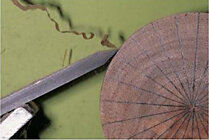I picked up a copy of Mike Darlow's Fundamentals of Woodturning at a recently deceased club member's estate sale. The chapter on Cutting and Tools is well worth reading for anyone interested in the technical aspects of slicing and scraping wood on a lathe. ...
That's an exceptional book. When I started I learned most of my woodturning from two books, Darlow's "Fundamentals" and from "Turning Wood" by Richard Raffan.
I read every page multiple times and did every exercise, repeated until everything fell into place. I still use those two books today for reference and to show students and buy extra copies when I can find them used (and cheap) to keep on the shelf and loan out. My little shop library is about full now but those two books are always at the end and easy to grab! I think I have all of both Darlow's (Woodturning Design, ... Methods, ... Techniques) and Raffan's books - can't get too much information. (I also have the chessman book but haven't read it yet.)
Some people have told me they don't like Darlow's book as much, seeing him as "too technical". This is a non-issue to me. I love his clear diagrams and detailed explanations and wonderful photographs of things like the differences in clearance angles and peeling cut in action. I think understanding the why instead of simply the how adds a lot to life!

BTW, I agree with honing the cutting edges. Further, I typically sharpen on a 600 or 1200 grit CBN wheel, then use the leather stropping wheel on the Tormek to remove any grinder burr. (This burr is pretty small with the fine wheel but it's still present.) Stropping on the wheel with a little of the Tormek honing/stropping compound (3 micron) leaves a "shaving sharp" edge. After some use, I touch up the edge a few times with my favorite little paddle hone, the extra-fine EZE-Lap before going back to the fine grit CBN wheels. Honing is trivial when sharpening with a wheel since the bevel is slightly ocncave since the hone can be held against the edge and heel at the same time.
EZE-Lap diamond hones:
I only use the extra fine blue for lathe tools and occasionally the red fine hone, but the set of three from Amazon is usually cheaper than buying the two individually. I like these so much I contacted EZE-Lap once and bought a "lifetime" supply of the two grits, more of the blue than the red.
This is the stropping/honing compound I prefer, although a bar of polishing compound rubbed onto the leather will work.
If stropping with a piece of leather on the bench, I found it's best to not use a piece thick, easily compressed leather. I think it's far better to use thin leather glued to a board with some kind of polishing/honing compound on the surface. This is what I use for my chip carving knives which NEED to be "scary sharp" to work!
Leather strop, thin leather mounted on flat hardwood. This strop will NOT round over the edge on your knife. Size: 10" x 2" x 1" Rub in some honing compound and strop a razor edge on your carving knives.

mychipcarving.com
For scrapers, after removing the grinding burr I use a burnisher to raise a working burr. In my experience, a burnished burr lasts far longer than a grinder burr.
A burnisher can be a carbide or hardened steel rod, the smaller the diameter the better. I've tried a bunch over the years and the Arno is my hands-down favorite:
(I sharpen with the 1200 grit CBN for spindle gouges, 600 grit for everything else.)
JKJ




